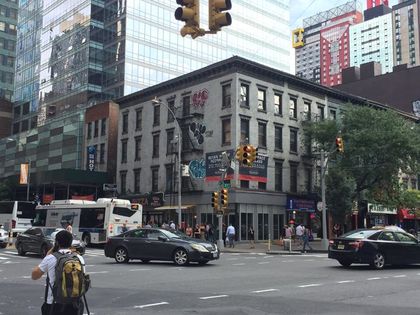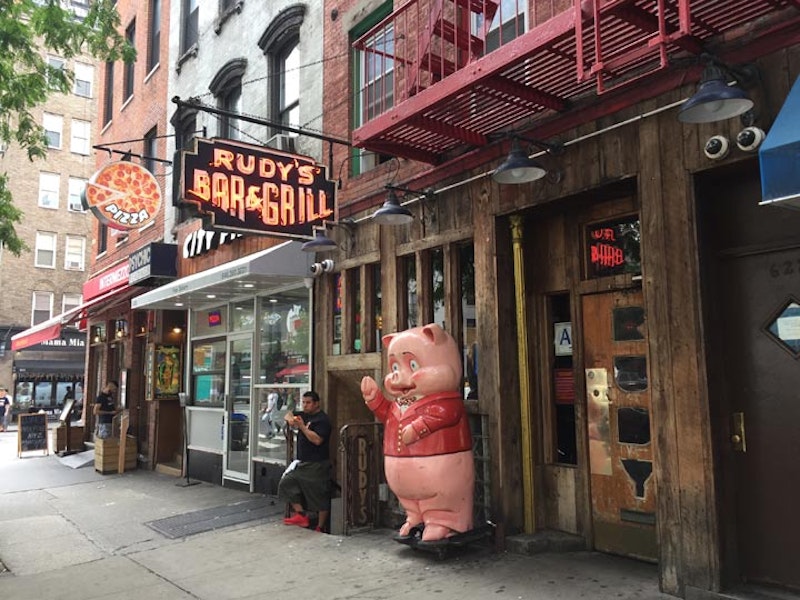I had an interview for a job at Varick and Houston Sts. in a subset of the West Village recently dubbed “Hudson Square.” In recent years, a number of businesses, as well as “shared office spaces” have gravitated to the tremendously large loft buildings that line Varick. I’ve worked here before—in 1992 I was an editor/Linotype operator in a brick building on Greenwich. There was a loading dock on the first floor and the office itself was like a museum of typesetting, with ancient machines not used for decades. The building itself was recently torn down, a fate of many of my old workplaces. Even the concept of “office space” has irrevocably shifted in just the last couple of decades. At the well-known direct marketer in Long Island I worked in for over a decade, I had my own office, requiring a key to enter, and eventually an office partner; he shared his surname with General Sherman’s horse, Rienzi.
Over the years, managements have chafed at the idea of everyone having their own space, so many non-managerial workers were placed in cubicles until the cubicle was dropped entirely, and everyone now works at lengthy tables with computer consoles. The cacophony is unsettling as everyone yaps into their phones making business calls. I wear bulky headphones pumping Spotify or IHeartRadio to block them out.
Anyway, I was let out early from my present temp gig near Columbus Circle at 3:30, as there wasn’t much for me to do. I had requested the interview at six p.m. since I usually get out at 5:30. How to kill the two and a half hours? I have my two legs and an iPhone camera, so I set off down 9th Ave., a boulevard I hadn’t walked of late, and then intended to turn down Hudson to Houston.
At 9th Ave. and 44th I encountered Rudy’s, one of the definitive dive bars of Manhattan. The neon sign advertising a grill is true in this case, as Rudy’s offers a free hot dog per customer with a drink purchase. Rudy’s and its neon sign have been on 9th since the 1930s (in the early days it was also known as Helen’s Bar & Restaurant). The booths are comfortable red leather, but have been duct-taped. Rudy’s had been famed for its old school jukebox stuffed with jazz records, but it’s been replaced. Beers are $3, while Rudy’s offers what it calls a “stimulus package”: a beer, a shot and a hot dog for $5.

High above 9th Ave. and W. 44th I spotted a faded sign: “Scribner’s.” It’s atop a brick building at 311 W. 43rd St. that was once a printing pant for the Scribner’s publishing house, which was founded by Charles Scribner I (1821-1871); it later published Hemingway, Fitzgerald and Vonnegut. The company merged with Macmillan, which then merged with Simon & Schuster. For many years Scribner’s also maintained a gorgeous retail bookstore on 5th Ave., which is still intact but has hosted many different varieties of retail since the bookstore closed in 1988, including cosmetics, women’s exercise clothing, and ironically, a Brentano’s bookstore.

Though its building is intact and its sign is still visible behind scaffolding on W. 42nd, The Elk Hotel, one of the last grand old flops of the Deuce, got out of the accommodations business in 2012. A TripAdvisor review stated: “As a former crackhead this hotel is the scariest place I’ve ever seen. I felt more safe and comfortable in jail.” The Elk was built on the southwest corner of 9th and W. 42nd St. in 1925 and catered to a stream of winos, hookers, johns and junkies for nearly 80 years. The price was right compared to other nearby accommodations: $40 per night, or $5 an hour if you wanted a quick flop. To the end in 2012, The Elk served people just arrived from the nearby Port Authority Bus Terminal, and several intriguing interior photos can be seen at the Facebook Elk Hotel Appreciation Society.

The Famous Original Ray’s Pizza can be found on 9th Ave. just south of W. 23rd, but don’t be fooled. The “true original Ray’s” was opened on Prince Street in Little Italy by Ralph Cuomo in 1959. By the 1990s, so many various Ray’s had sprung up that Jerry Seinfeld, on his much-syndicated TV show, asks Kosmo Kramer whether he is calling from outside Ray's Pizza, Famous Ray's, Original Ray's, or Famous Original Ray's. Ralph Cuomo’s Ray’s Pizza on Prince Street closed in 2011.

The White Horse Tavern is another of NYC’s long-lived literary hangouts, and yet another with an ancient neon sign. It has been here on Hudson Street and W. 11th since 1878, replacing the James Dean Oyster House. And one of the White Horse’s patrons was indeed too fast to live and too young to die. Dylan Thomas (1914-1953) was born in Swansea, Wales and surprisingly enough, didn’t visit the USA until 1950. Thomas first came to prominence as a poet with Eighteen Poems in 1934; his most famous work is perhaps “Do Not Go Gentle Into That Good Night.” His prose works include A Child’s Christmas in Wales and the play Under Milk Wood, both published posthumously in 1954.
Why are so many of our most creative individuals given to dissolution and self-destruction? Thomas, the story goes, drank himself to death at the White Horse in November 1953, but the story is more complicated than that: the writer had been quite ill that year, and a number of factors likely contributed to his demise.
A visit to the White Horse today provides a relaxed atmosphere, especially in the front room where you watch the Village go by out the window. Check for how many representations of white horses you can find! The place is under new management, and prices have been raised somewhat, but it’s the same as it ever was.
—Kevin Walsh is the webmaster of the award-winning website Forgotten NY, and the author of the books Forgotten New York (HarperCollins, 2006) and also, with the Greater Astoria Historical Society, Forgotten Queens (Arcadia, 2013)

